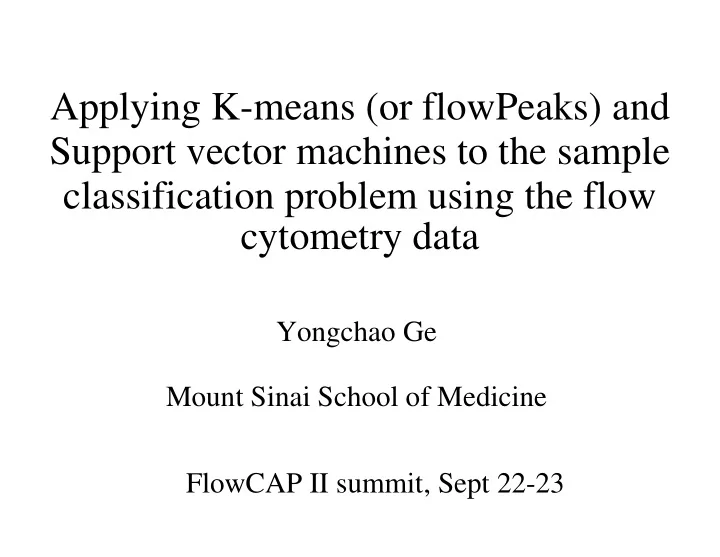

Applying K-means (or flowPeaks) and Support vector machines to the sample classification problem using the flow cytometry data Yongchao Ge Mount Sinai School of Medicine FlowCAP II summit, Sept 22-23
Outline • Objective • Kmeans and flowPeaks • Support vector machine • Results and discussion
Objective To build a good classifier for the flow cytometry • data Step 1: data reduction --- kmeans, flowPeaks • Step 2: machine learning --- support vector • machines Using cross-validations to assess the algorithm • performance
Kmeans algorithm • MacQueen (1967) used the name Kmeans, the idea goes back to Steinhaus (1957), Lloyd (1982) algorithm was proposed in 1957 (wikipedia). • An iterative algorithm with the two steps: Cluster assignment Center update • Critical parameters: Initial seeds The number of clusters K
Adapted from Jain 2010
Kmeans implementation details The initial seeds are generated by k-means++, • which tries to generate the seeds that are well separated The data are organized by k-d tree to increase • the computation speed The determination of K. Roughly , we fix it • n to be 300 for flowCAP challenges. 1. to keep as many features as possible 2. to make sure the estimate of the proportion has a smaller variance
flowPeaks (manuscript in progress) • It uses the initial Kmeans clustering to build the density function and compute all of the peaks of the density function • The data are reclassified by the local peaks of the density function • A web interface will be up on the lab site soon.
Support vector machines For a two-class linear separable problem, the goal is to find the a hyperplane that is furthest from both classes (or maximize the margins) The problem setup 2 min , w / 2 w b ⋅ − ≥ ∈ w x b 1 y class 1 i i s . t . ⋅ − ≤ − ∈ w x b 1 y class - 1 i i Where x i is the data and y i is the class label.
An example Adapted from Bennett and Campbell, 2000
What if the space not linear separable n ∑ 2 + ⋅ min w / 2 C z w , b i = i 1 ⋅ − ≥ − ∈ w x b 1 z y class 1 i i i s . t . ⋅ − ≤ − + ∈ w x b 1 z y class - 1 i i i Where relaxed variables z i and the penalty cost C are non-negative .
SVM Support vector machine is a very powerful machine learning algorithm 1. It does not have the over-fitting problem for the high dimensional data. 2. It can accommodate nonlinear classification by applying suitable kernels 3. The computation is fast 4. It extends to more than two classes, regression, and novelty detection.
Software choice There are a lot of implementations available for SVM. libsvm, R package e1071, weka, SVM light Our choice is WEKA as it offers different machine learning algorithms and different SVM implementations. We fixed the optimization by SMO. We used linear kernel with degree of 1 with the penalty cost C=1.
Variable normalization and filtering A variable if filtered out if its mean proportion between the two groups is less than 0.1% or the pval from the t-test is greater than 0.5 The remaining variables are normalized with mean 0 and std 1.
Challenge 3A 1. Randomly take 5000 cells from each file, to combine into a big file and compute the K- means with K=300 2. Apply the 300 centers to each file to compute the prop. of cells belonging to each center 3. Normalize the prop vector by subtracting the average of the two antigens 4. Apply the SVM to the normalized proportions.
A naïve hierarchical clustering can give a classifier with 6 errors out of 54. For 100 trials of three fold random cross- validations, 99 trials give zero errors out of 54, and 1 trial give two errors.
Using negctrls to normalize the data • Alternatively, we compute the K-means include the data from the negtrls and NAs, in addition to the two antigens • Using the average of the prop vectors from the negctrls to normalize the data • The hierarchical clustering is not that clean • The SVM gives identical prediction as before • 100 trials of cross-validation of the training data set gives more errors
Cross-validation comparisons For 100 trials of 3 fold cross-validations. # of errors out of 27 0 1 2 3 4 5 6 ENV 99 1 Normalize with antigens GAG 99 1 ENV 8 29 33 17 11 1 1 Normalize with negctrls GAG 89 11
Results for Challenge 2 • Compute the flowPeaks for each tubes and each group of patients (aml and normal) independently • For each patient, compute the 16 prop vectors (8 tubes x 2 conditions) using the results from flowPeaks • Using the 16 prop. Vectors as the input to the SVM.
Cross-validation comparisons For 100 trials of 3 fold cross-validations. # of errors 0 1 2 3 4 5 >5 flowPeaks Aml (23) 8 25 28 21 13 5 Normal (156) 44 30 19 6 1 Kmeans Aml 14 28 31 27 Normal 16 58 23 3
Challenge 2: flowPeakssvm
Challenge 3A: Kmeanssvm
Compare the cross- validations and independent test set The cross-validations give higher error rates. The ideal cross-validations should include the building of the k-means of flowPeaks, which may raise the error rates slightly Possible explanations? • The “training data” is the cross-validation is smaller • The independent test data is less challenging than the training data set
Discussions and Caveats • Different normalization gives different strengths • The machine learning can be improved with a better selection of the parameters to train the SVM.
Acknowledgement • Stuart Sealfon • Fernand Hayot • Istvan Sugar • Boris Hartman • Maria Chikina • Grant support: NIH/NIAID HHSN272201000054C
Recommend
More recommend